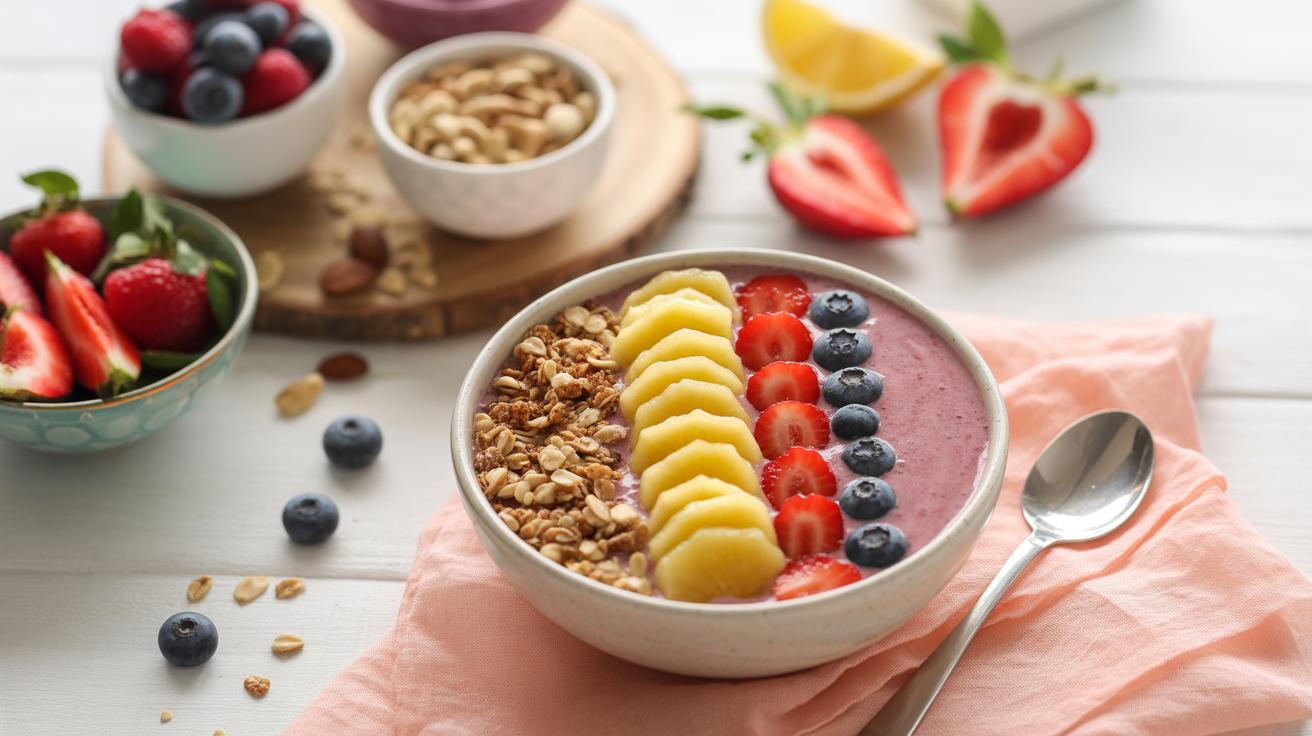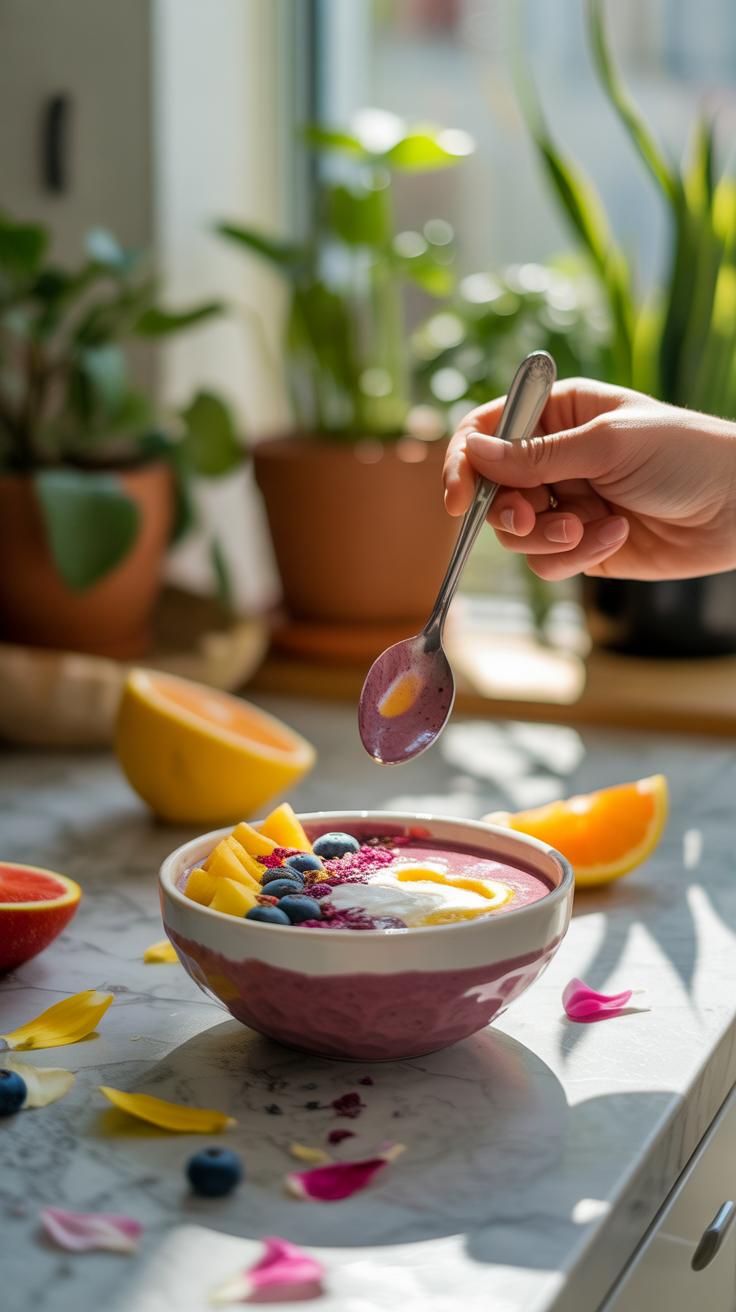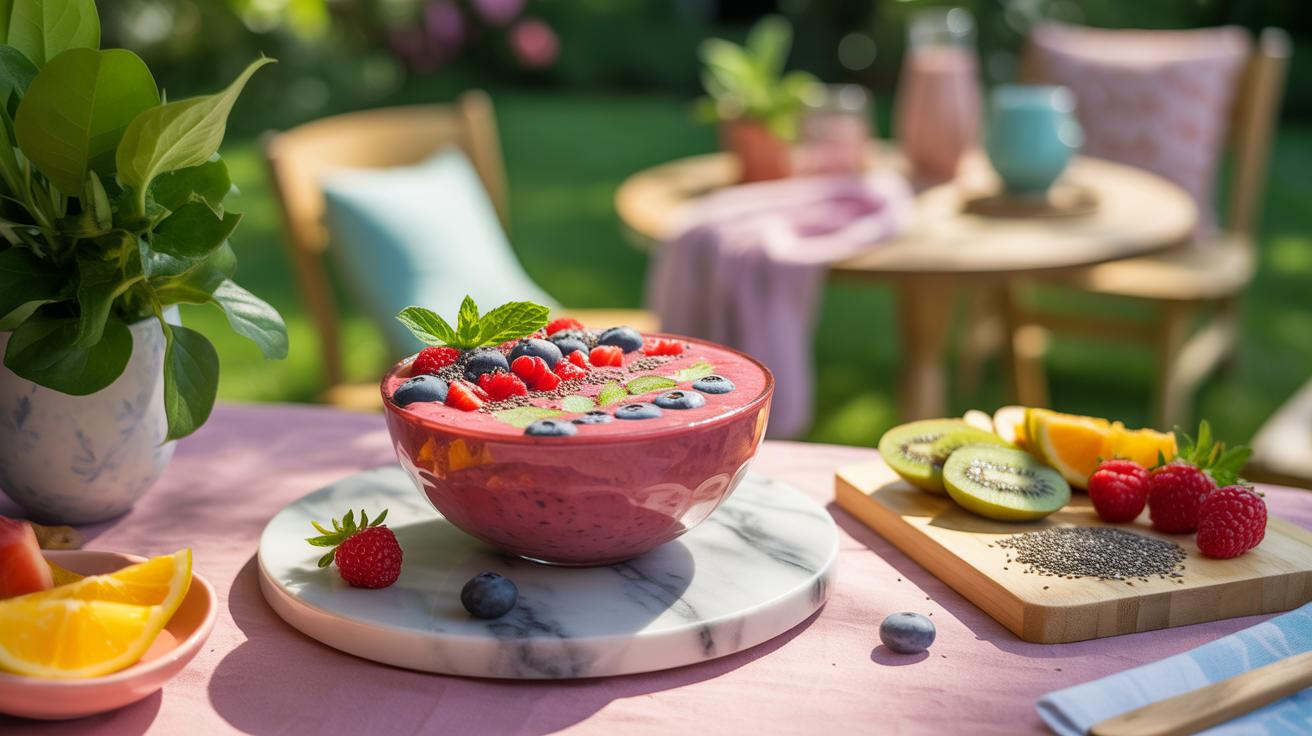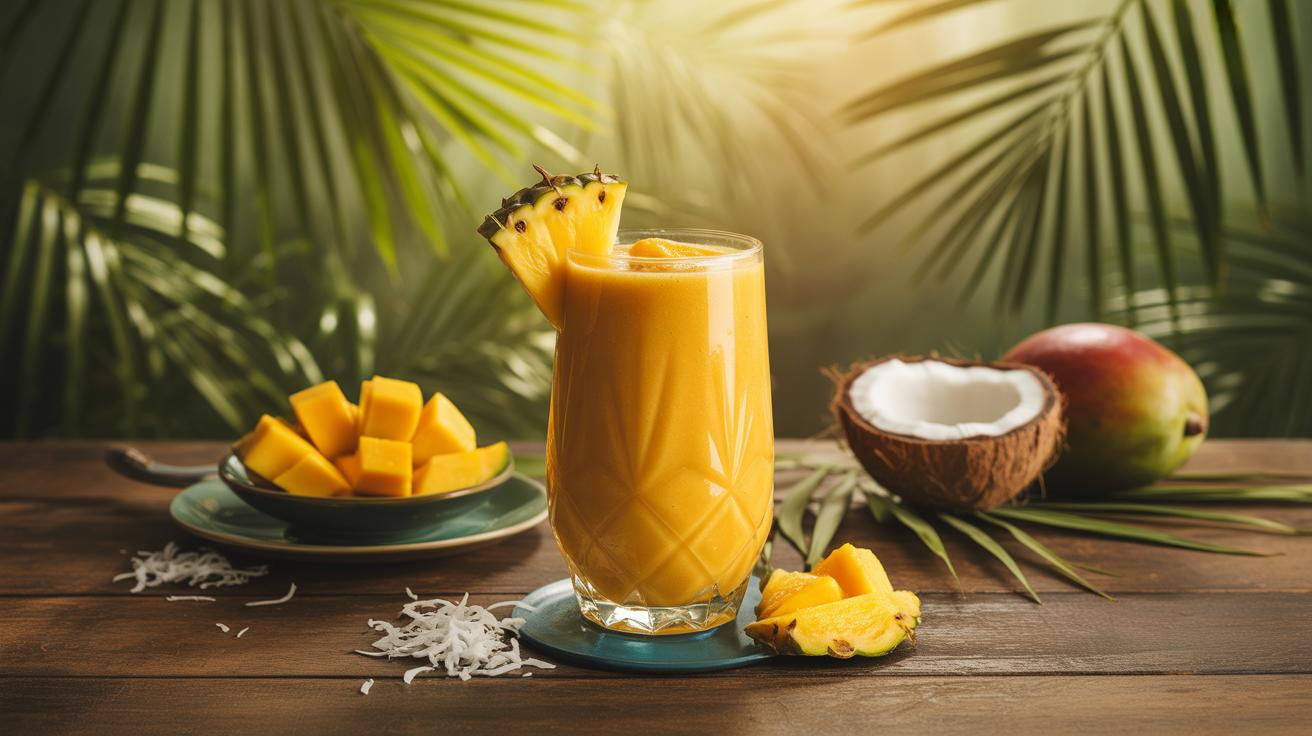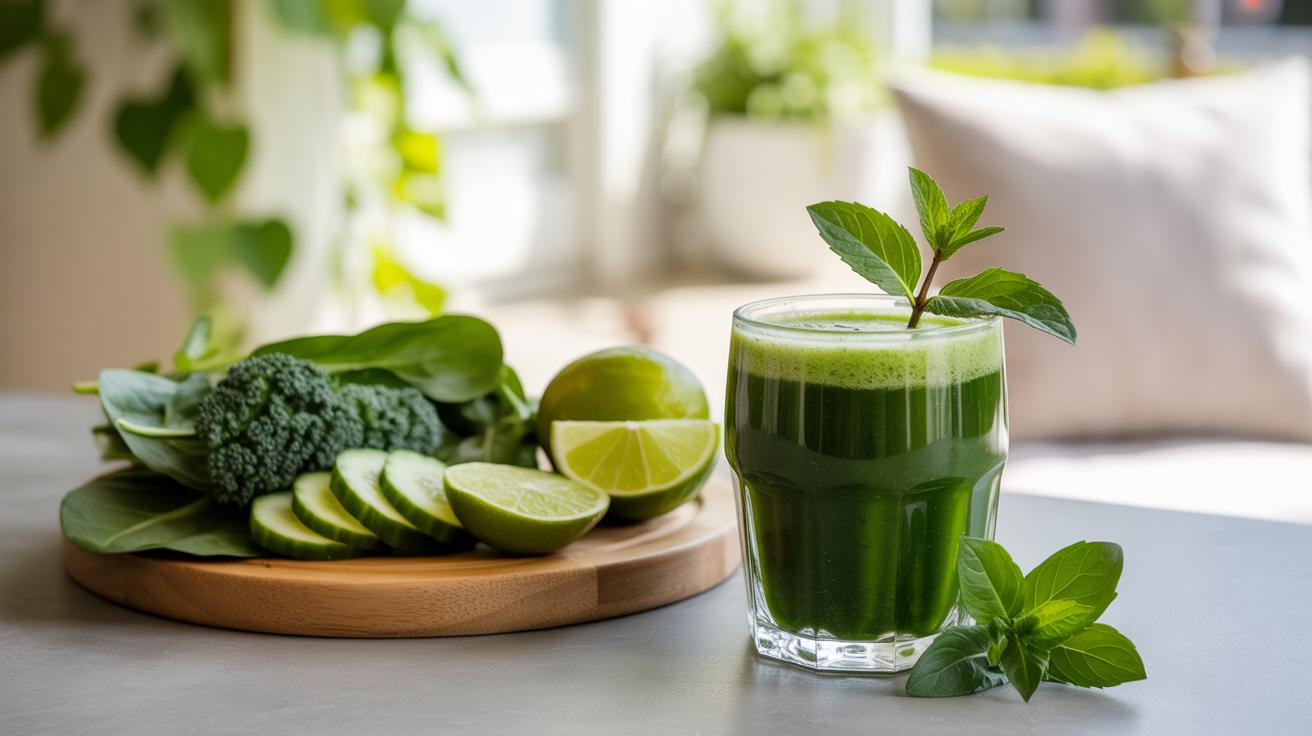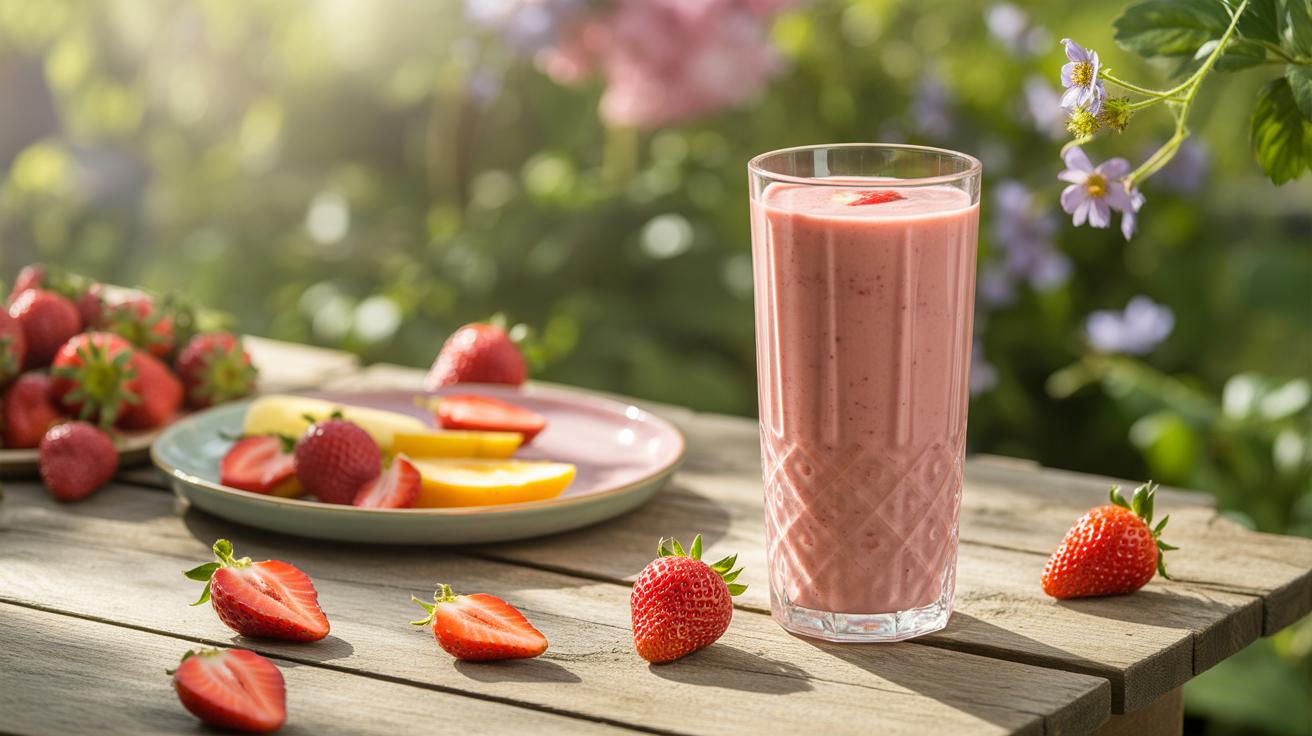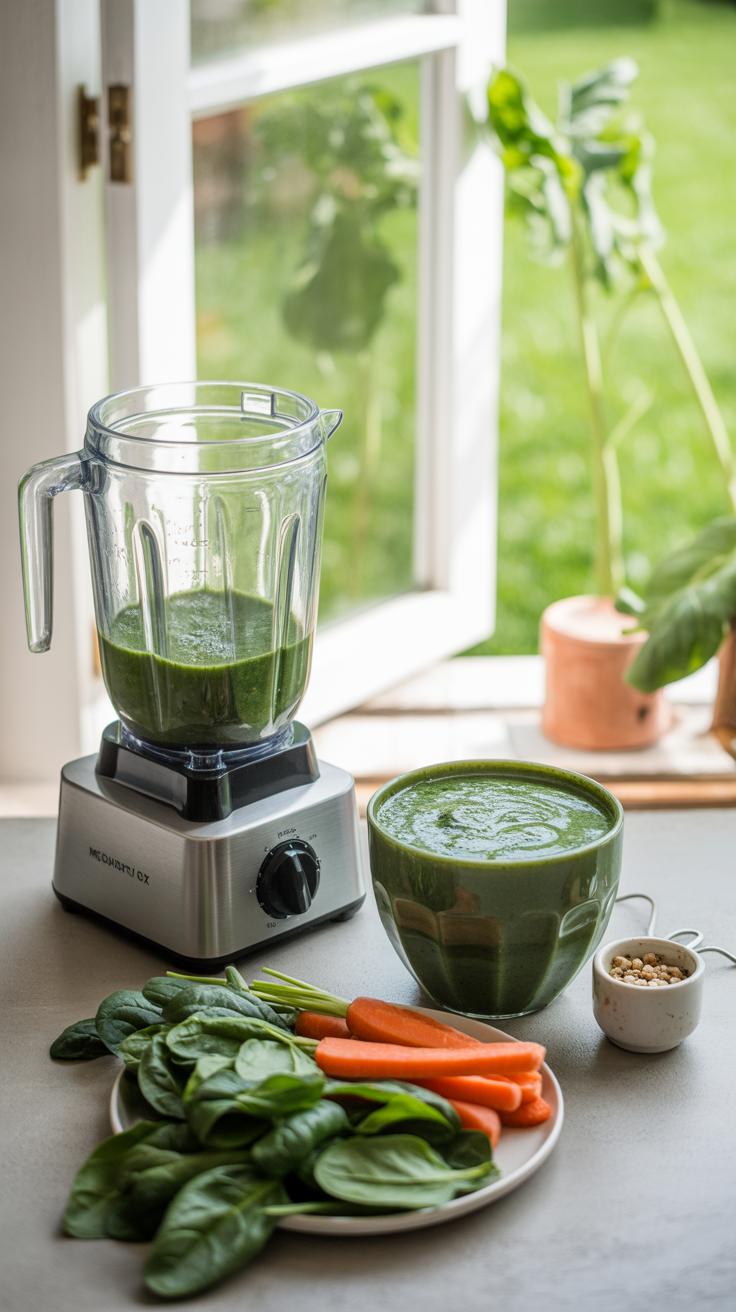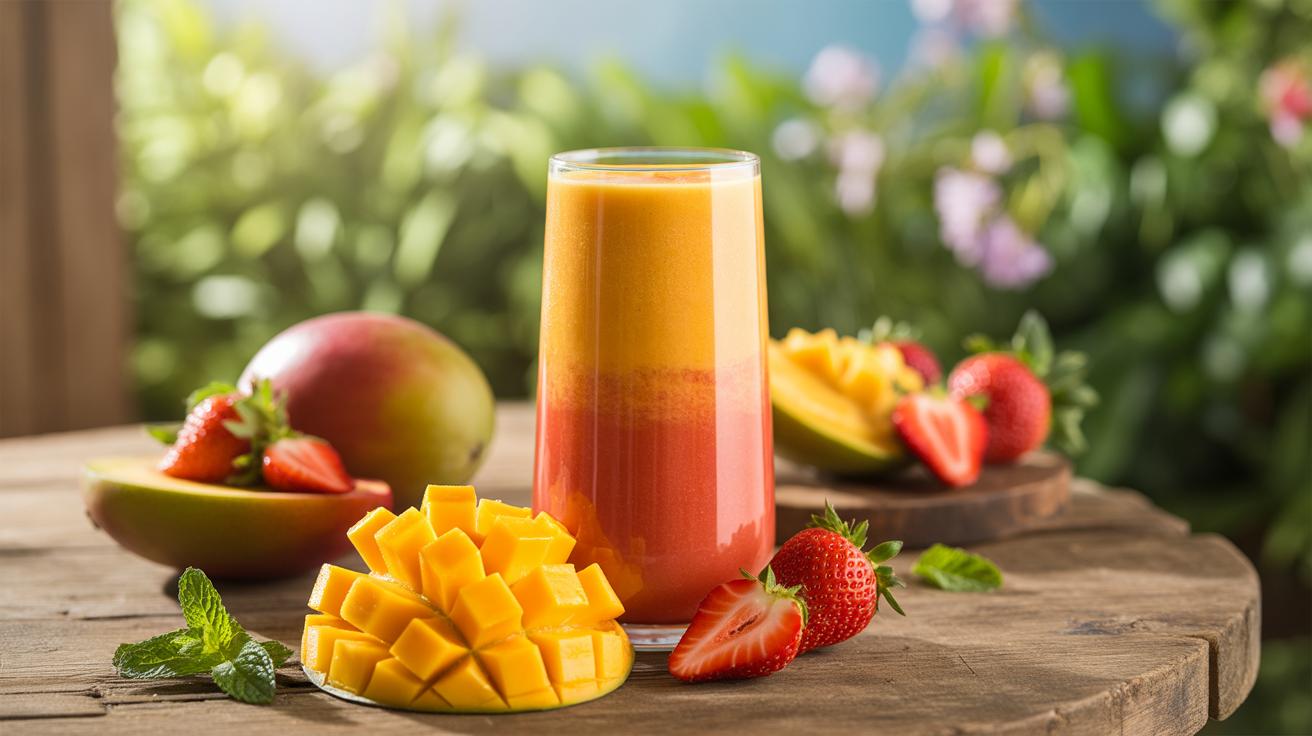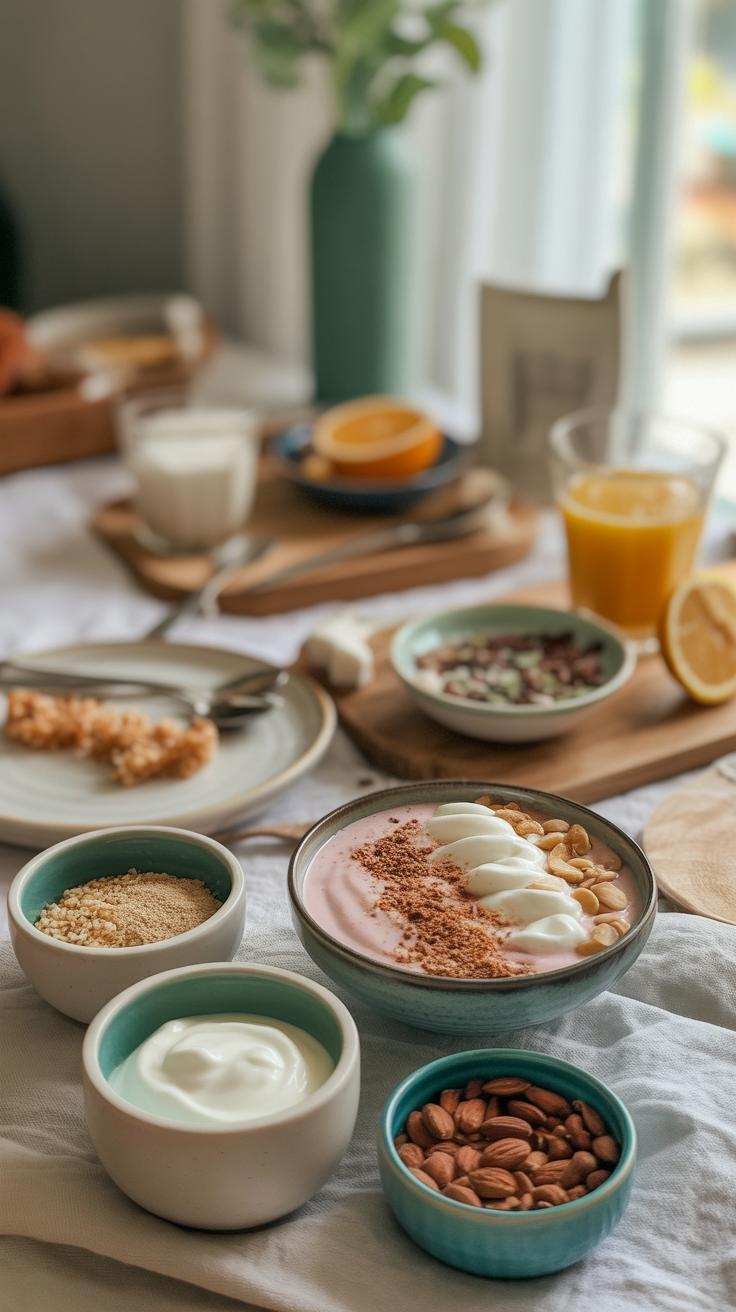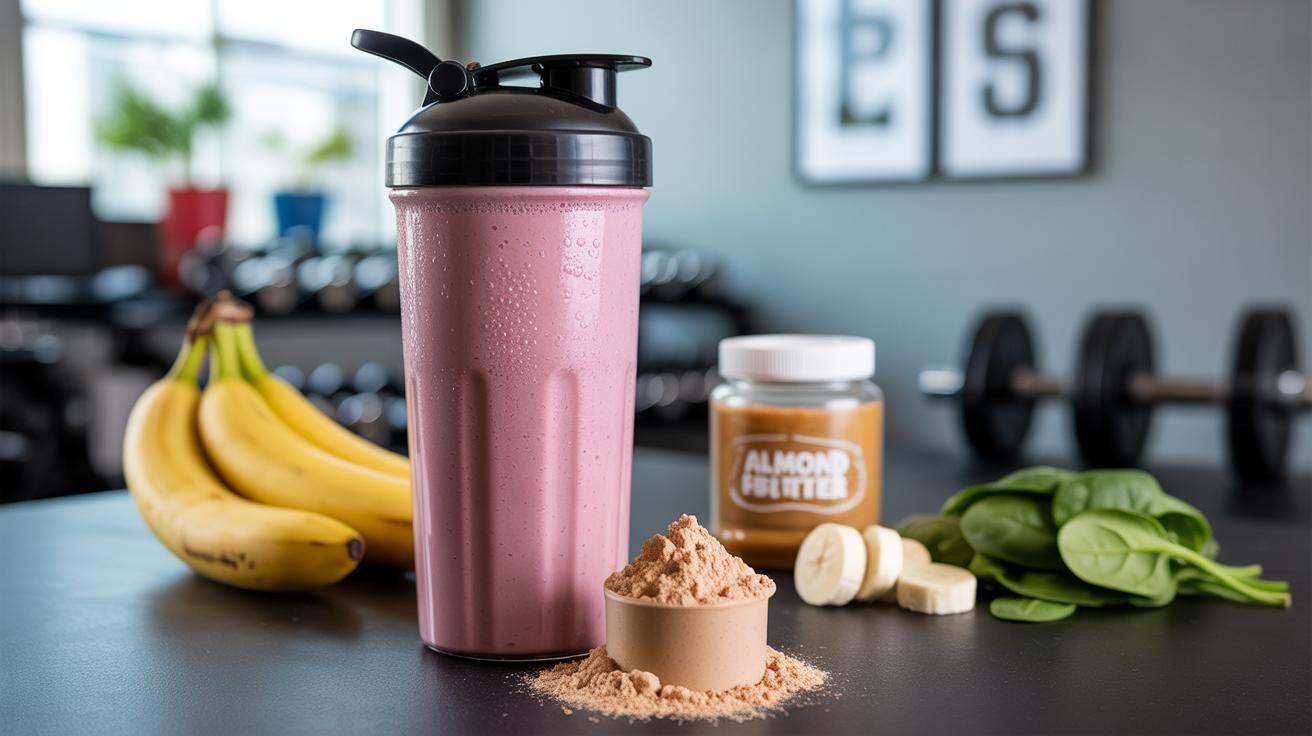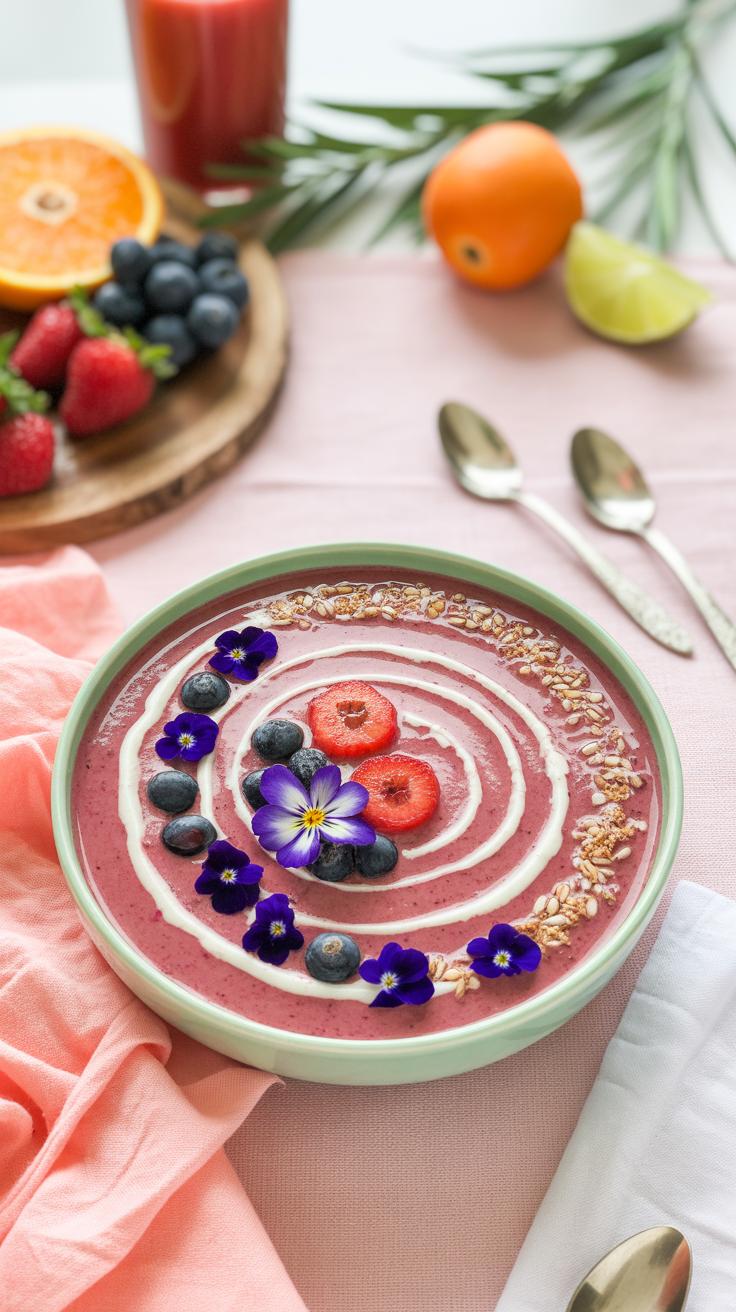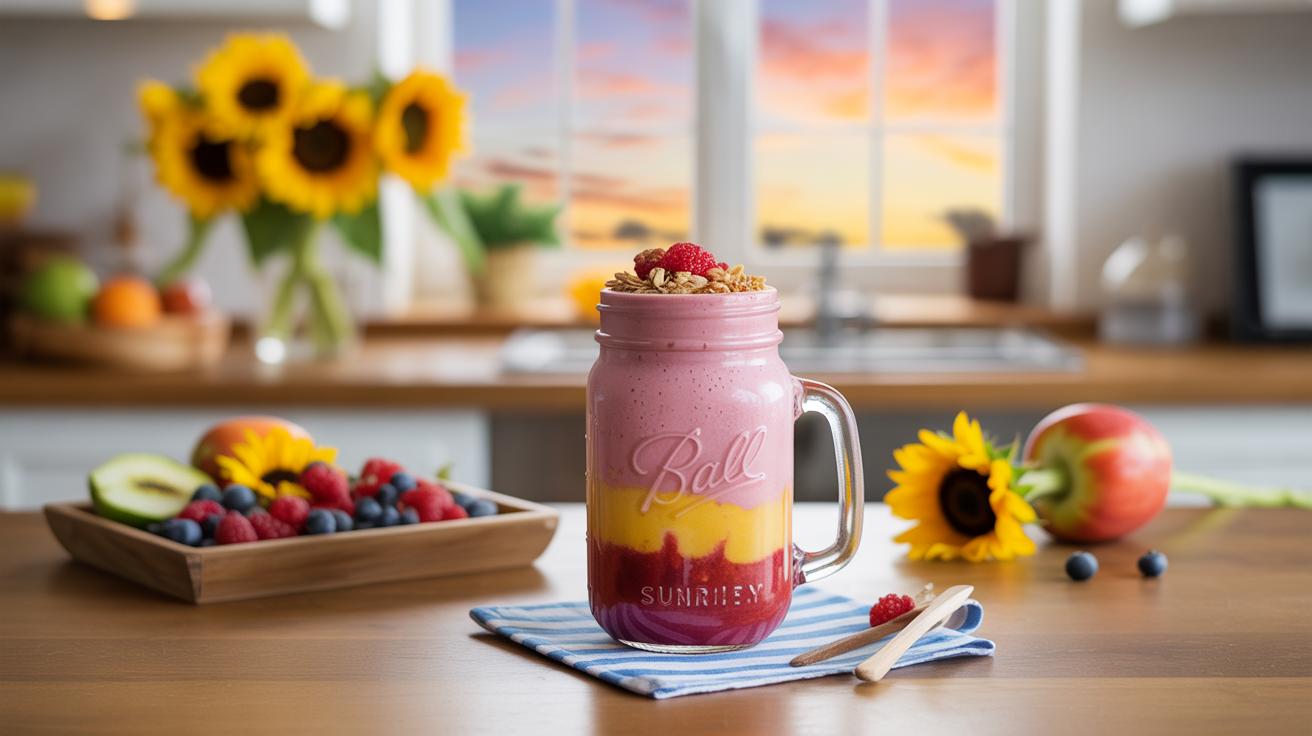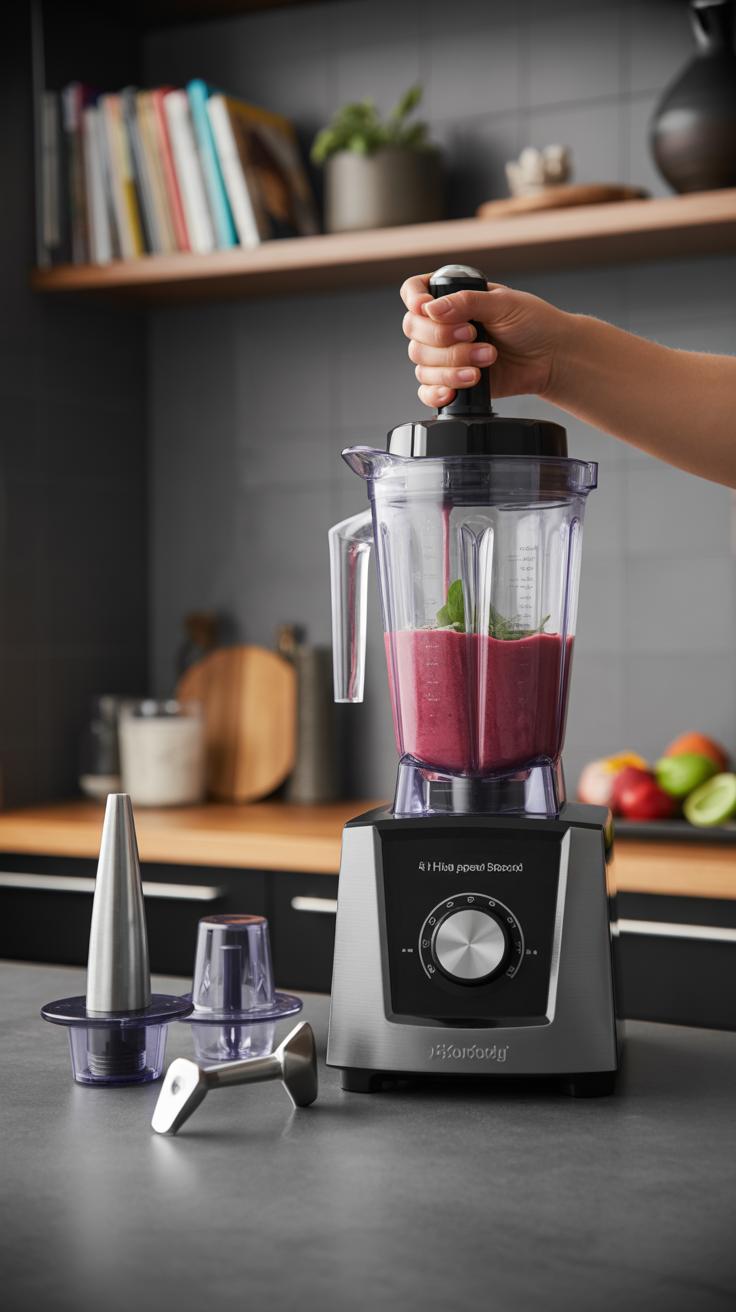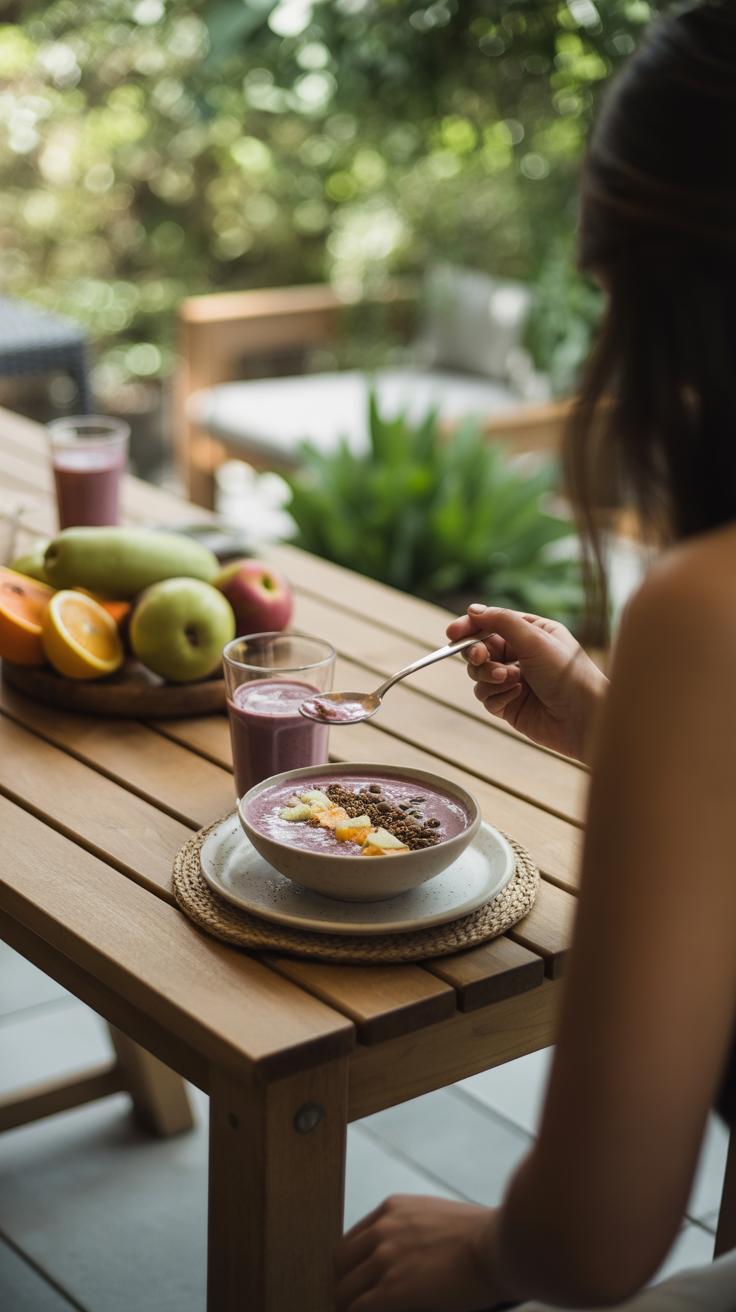Introduction
Easy Smoothie Bowl Recipe With Fresh Fruits offers a fresh way to enjoy your daily fruits. Smoothie bowls are thick, creamy blends of fruits, often topped with fresh fruits, nuts, and seeds. This article explores how to prepare a delicious smoothie bowl that is both nutritious and easy to make.
You will learn the basics of smoothie bowls, the assembly process, ingredient options, and tips to make your breakfast or snack a delightful experience. By the end, you’ll have clear steps and ideas to create your own fresh fruit smoothie bowls every day.
Understanding Smoothie Bowls
A smoothie bowl is like a thicker, more substantial cousin of the typical smoothie you might sip through a straw. Instead of a drink, it resembles more of a creamy, spoonable meal. The texture is key—smoothie bowls are dense enough to hold various toppings on the surface, giving you a bit of crunch or chew with every bite. They usually combine frozen fruits, sometimes with yogurt or a splash of milk, blended until thick. Then, fresh fruits, nuts, seeds, or granola are added on top.
It’s not just about texture, though. A smoothie bowl invites you to slow down and enjoy the layers of flavor and texture instead of gulping something down quickly. Nutritiously, they pack the goodness of fruits, fibers, and healthy fats—making them more filling and balanced compared to plain fruit juices or smoothies.
What Makes a Smoothie Bowl
The standout feature is the consistency. Imagine a smoothie thick enough to scoop with a spoon without it melting away instantly. That thickness comes from using frozen fruits or a smaller amount of liquid when blending. Because you eat it with a spoon, toppings matter a lot—they add crunch, contrast, and even extra nutrition.
Besides the physical difference in how you consume it, smoothie bowls offer a different kind of eating rhythm. You take your time, mixing bites of creamy base with vibrant toppings. This makes it feel more like a breakfast or snack than just a drink.
Why Choose a Smoothie Bowl
Picking a smoothie bowl can change the way you feel after eating. For one, the thick texture paired with wholesome toppings can keep hunger at bay longer. It’s the fiber and protein from nuts or seeds that help here, not just the sugar from fruit. Sometimes, I find myself more satisfied—less tempted to reach for a second snack soon after.
Then there’s the experience itself. Eating a smoothie bowl feels a bit more deliberate and satisfying than gulping down a smoothie. There’s that mix of textures and the ability to customize each bite, which turns eating into something enjoyable, not just functional.
Does choosing a smoothie bowl mean you’ll always pick the healthiest option? Not necessarily—but it gives you a chance to add nutrient-rich ingredients that might not work as well in a liquid form.
Choosing the Right Fruits
Picking fresh fruits for your smoothie bowl is more than just grabbing what looks good. Taste plays a big role—you want a balance between sweet, tart, and mild flavors so the bowl is enjoyable, not overwhelming. For example, pairing a ripe banana with tangy kiwi can create a nice contrast that wakes up your palate.
Texture also matters. Fruits like mango or peach blend smoothly and create a creamy base, while berries add tiny seeds and a bit of chewiness that lend some bite. Sometimes I prefer softer fruits to keep it silky, but occasionally those little crunchy bits from seeds keep things interesting.
When it comes to nutrition, fruits like blueberries, strawberries, and oranges are packed with antioxidants and vitamin C, which help keep your immune system in check. Apples and pears add fiber, keeping you full longer. You could focus solely on health, but flavor and look shouldn’t be ignored—they’re what make eating the bowl a treat.
Fruits for Flavor and Color
Choosing fruits that taste good together and look appealing is a bit of an art. Bright reds from strawberries or raspberries mix beautifully with the golden hue of mango or the deep purple of blackberries. It’s not just about looks; these colors hint at different nutrients too.
Think about how flavors interact: sweet fruits like bananas or cherries often pair well with sour ones like pineapples or citrus. I sometimes try unexpected combos, like kiwi with blueberries, and it surprises me how well they complement each other—both in flavor and color, making the bowl inviting.
Fruits for Nutrition
If you want to boost your smoothie bowl’s health factor, opt for fruits rich in vitamins, fiber, and antioxidants. Berries—blueberries, raspberries, blackberries—top the list for antioxidants, which protect cells and reduce inflammation.
Citrus fruits bring vitamin C, aiding in skin health and immune support. Bananas offer potassium, which is great after a workout. Apples supply fiber that helps digestion. Including a variety ensures you’re not just filling the bowl with sugar, but with nutrients that serve your body well.
Have you ever noticed that some fruits make you feel more energized, while others soothe you? Mixing and matching based on how you want to feel might be worth trying. After all, the best smoothie bowl is one that tastes good and makes you feel good too.
Selecting Liquid Bases
Your choice of liquid can change a smoothie bowl’s whole personality. Think about it—sometimes you want something creamy and rich, other times light and refreshingly simple. Picking the right liquid base impacts both texture and taste more than you might expect.
Milk and its alternatives tend to create a thick, velvety texture. If you go with dairy milk, you’ll get that classic creamy touch plus some protein and calcium. Plant-based milks like almond, oat, or soy bring different flavor notes—oat milk is naturally sweet and smooth, almond milk is a bit nuttier and lighter. Nutritionally, plant-based milks often have fewer calories but watch for added sugars or fortification levels. Choosing one depends on whether you want creaminess or a lighter overall feel.
Juices give a different vibe. Fruit juices, like orange or pineapple, can add a natural sweetness and tanginess. They thin out the bowl and can brighten the taste, but that can come with extra sugar and fewer nutrients compared to milk. Using water offers the most neutral base; it lightens the blend without stealing any flavor, perfect if you want to highlight your fruits or keep calories low.
Try thinking about what mood you want in your smoothie bowl: richer and satisfying, or fresh and easy. Does the liquid invite you to savor each bite slowly, or fuel you quickly? It might be worth experimenting. I often start with oat milk for its mild sweetness, but sometimes just water if I’m after a very fresh finish.
Adding Vegetables for Health
Adding vegetables like spinach and kale to your smoothie bowl might feel a bit tricky at first. You might worry they’ll mask the fruity flavors or make the texture less appealing. But honestly, these greens blend in surprisingly well, especially when you choose the right types. Spinach, for example, is pretty mild and almost neutral in taste. It mixes smoothly without making the bowl taste “green” or bitter. Kale, while a bit stronger, can still work if you use just a small amount. You can even try baby kale, which tends to be less intense and softer.
Picking mild-tasting greens is key. If you start with anything too strong—like mature kale or collard greens—they might overpower your fruits. So, think about greens that have a naturally subtle flavor and tender leaves. Swiss chard, baby spinach, or even a mild romaine can be good options. Another trick is to chop them finely or blend them really well so their texture disappears into the creamy base, making your smoothie bowl still feel light and fresh.
Why bother adding vegetables? They pack your smoothie bowl with more fiber than fruits alone. That helps with digestion and keeps you feeling full longer. Plus, you get a wider range of vitamins such as A, C, K, and several minerals. These nutrients boost your immune system and support healthy skin and bones. It almost feels like sneaking in an extra serving of veggies without the usual effort. Does that mean your smoothie bowl suddenly becomes more “healthy”? Maybe. But it’s definitely more balanced and interesting.
Sweeteners and Enhancers
When it comes to sweetening your smoothie bowl, natural options like honey or maple syrup often feel like the safest bets. They bring gentle sweetness without the sharpness of processed sugars. But here’s the thing—using these sweeteners sparingly is key. You want just enough to balance out tart fruits or mild greens without overpowering the fresh flavors.
For example, a teaspoon of honey stirred into a berry-based bowl can add a subtle warmth. Maple syrup works well if your smoothie leans towards fall flavors, or you’re using nuts and oats in the mix. The tricky part is that sweetness is subjective. Sometimes I hesitate, wondering if I’ve added too much or too little, but starting small always feels like a good move.
On the flavor side, spices and extracts do a good job of adding depth without extra calories. Vanilla extract can soften and round off the sharpness in citrus or green smoothies. A pinch of cinnamon injects a slight warmth and complexity, especially with banana or pumpkin blends. These are little surprises that make your bowl interesting without any sugar crash worries.
Here’s a quick thought list to guide you:
- Use teaspoon-size portions of honey or maple syrup at first—adjust after tasting.
- Try vanilla extract to smooth out flavors, but only a drop or two; it’s potent.
- Sprinkle cinnamon or even nutmeg lightly to enhance sweetness naturally.
- Consider lemon zest or fresh ginger for an unexpected brightness instead of sweeteners.
Is adding natural sweeteners really necessary? Sometimes the fruit’s own sugars do the job. But when you do add sweeteners or enhancers, they should feel like complements, not the main event.
Protein Options for Smoothie Bowls
Adding protein to your smoothie bowl does more than just fill you up—it also balances the nutrients, making your breakfast or snack more satisfying. Yogurt and nut butters are especially good for this. They bring a creamy texture that makes the bowl feel richer and more indulgent without adding too much fuss.
Yogurt, especially Greek yogurt, packs a punch with its protein content. It blends smoothly into the mix and gives a subtle tanginess. Nut butters like almond or peanut butter not only add protein but also a nice depth of flavor. Sometimes, a spoonful of nut butter turns a simple fruit smoothie into something that feels like a treat, though it can get a bit heavy if you go overboard.
Protein powder offers a more flexible option. When picking one, consider its taste first—some powders can taste chalky or artificial, which might overpower the fresh fruits. It’s best to start with a smaller amount and blend thoroughly to avoid clumps. Whey protein typically dissolves well, but plant-based options like pea or rice protein sometimes need a bit more blending or extra liquid.
Think about your goals too: are you after more muscle fuel or just want to stay fuller longer? That might shape your choice. Using protein powder can make the bowl denser, so you may want to adjust your toppings or the liquid amount to keep it enjoyable to eat.
Creating Beautiful Toppings
When it comes to choosing toppings for your smoothie bowl, you want to think beyond just flavor. Fresh fruits are a natural choice—berries, kiwi, mango, and banana bring vibrant colors and natural sweetness. Seeds like chia or pumpkin add tiny bursts of crunch and subtle nuttiness, while nuts such as almonds or walnuts introduce heartier texture. Don’t forget about extras like shredded coconut or even a drizzle of honey that can add an unexpected twist.
Mixing different textures creates a more interesting bite. Crunchy elements balance the softness of blended fruit, while sweet and tart toppings keep your palate engaged. For instance, pairing juicy pomegranate seeds with creamy sliced avocado can feel surprisingly pleasant. The contrast between a crisp apple chunk and smooth yogurt dollops can elevate the whole experience.
Visual appeal plays a big role too. Try arranging toppings in rows, clusters, or little patterns—something that makes you want to pause before digging in. Color variety helps; a sprinkle of dark blueberries next to bright orange mango looks inviting. Sometimes, a less perfect, more natural look works better—it feels homemade and genuine, kind of like a small work of art you can actually eat.
Blending Techniques and Tools
Getting the thickness just right in a smoothie bowl can be a little tricky. You want something dense enough to hold toppings without sinking, yet smooth enough to enjoy with a spoon. The blending process plays a big role here. It’s not just about throwing everything into the blender and hitting start.
First, picking the right blender makes a difference. High-powered blenders like Vitamix or Blendtec handle frozen fruits and thick ingredients smoothly. They can crush ice and fibrous materials better than cheaper models, which often leave chunks or a watery mix. That said, a mid-range blender with good speed settings might just do the job if you’re patient—or if your recipe uses softer fruits. The key is a motor that doesn’t overheat and blades that can create a vortex, pulling ingredients down evenly.
When you’re ready to blend, layering ingredients carefully helps too. Start with a small amount of liquid—like plant milk or juice—just enough to get things moving. Then add soft fruits or yogurts, followed by frozen chunks or ice. Pulse a few times before running the blender continuously, checking the texture as you go.
- Use short bursts at first to break up big pieces.
- Scrape down the sides periodically to mix in stuck parts.
- Add liquid gradually if the blend seems too thick or isn’t moving well.
- Stop when the texture is creamy but still thick—too much blending can over-thin your mixture.
Does your blender stall or sound strained? That usually means it’s too packed or needs more liquid. But if you add too much liquid too soon, the bowl becomes more of a drink, and that’s not what you want here. Finding the right balance is a bit of trial and error—I’ve had days when my bowl was more like a smoothie in a glass. Not bad, just a different experience.
Overall, be patient and don’t rush the blending. Taking your time will help you control the consistency in a way that feels right for your taste and the toppings you’ve prepared. You might find you prefer it thicker or slightly smoother, depending on what you plan to add on top.
Serving and Eating Your Smoothie Bowl
Serving Suggestions
Choosing the right bowl size can make a surprising difference. I usually go for something medium-sized—not too big that the smoothie starts melting before I finish, but not too small so it feels skimpy. A bowl around 6 to 8 inches wide works well. It gives enough space for layers and toppings without crowding.
Chilling your bowl beforehand helps keep everything fresh longer. Just pop it in the fridge or freezer for a few minutes before pouring in your smoothie. This little step slows down melting and keeps textures from blending together too soon. You might forget to do this once or twice—but honestly, your bowl will thank you when you do.
The timing matters here, too. Serve your smoothie bowl right after blending. Waiting is a gamble—fruit can oxidize and lose freshness. Plus, the texture changes. If you aren’t ready to eat immediately, cover it and stash it in the fridge for no more than an hour.
Eating Tips
When it comes to eating, don’t rush. I learned this the hard way, just diving in with a big spoon and missing out on the layered flavors. Try to savor a bit of every element in each spoonful. The crunch of granola, the creaminess of the base, the bite of fresh fruit—they all tell a small story.
Use a spoon that lets you get a little bit of topping with the smoothie beneath. A flat, wide spoon often works better than a tiny teaspoon. It’s about balance on the palate, I think. If you focus on just the fruit or just the toppings, you lose the joy of contrasting textures and tastes that makes a smoothie bowl so enjoyable.
Last thing: experiment with how you mix it as you eat. Some bites all together, some separated. This can change your experience more than you expect and might make you rethink the combinations next time.
Experimenting with Recipes
When it comes to smoothie bowls, I think the real fun starts with mixing and matching ingredients. You might have your go-to fruit combo, but trying out new blends can surprise you—maybe a splash of coconut water with mango and spinach, or a dollop of almond butter with berries and oats. What’s interesting is how changing just one element can shift the whole flavor and texture.
Think about pairing different liquids with fruits, like using green tea instead of almond milk for a subtle caffeine boost. Or playing with proteins—Greek yogurt, protein powder, or even silken tofu—to see what suits your taste and nutrition needs. And toppings? They’re not just for looks. Crunchy granola, seeds, fresh herbs, even a hint of spice can make a difference.
Keeping track of these experiments really helps. I started a simple journal—just notes about what I mixed, amounts, and how it tasted. Over time, patterns emerged. Certain combos worked better in the morning, others felt too heavy. You might find your favorites evolve, or that you like experimenting seasonally. Do you have a preferred fruit or topping that always works? Jot it down.
Have you ever thought about how your mood or energy level affects your choices? It’s worth wondering if some blends feel more comforting than others. Sometimes, the best recipes come from unexpected trials, and keeping a journal keeps those moments from slipping away.
Conclusions
Making smoothie bowls is a simple way to boost your fruit intake and enjoy a tasty meal. With fresh fruits, healthy toppings, and the right blend, you get a nutritious dish that supports your energy and health. You can customize your bowl to match your taste and dietary needs.
Start with basic recipes and experiment with fruits, liquids, and toppings. Your smoothie bowl can be a creative, enjoyable part of your daily routine. Try different combinations to find what you like best and keep the experience exciting.

